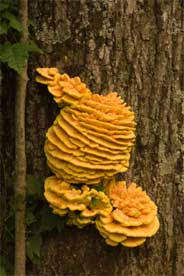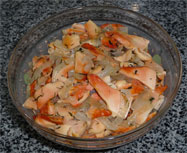https://www.mushroom-appreciation.com/chicken-of-the-woods.html
Chasing the Chicken of the Woods
One can easily spot the chicken of the woods mushroom by its impressive size and vibrant yellow-orange colors. This large polypore has surprised many a nature lover the first time they found it! Yet did you know they're also edible, and considered a delicacy in some parts of the world?
This mushroom has a lemony, meaty taste. Some think it tastes like its chicken namesake; others describe the flavor as being more like crab or lobster. Whatever your opinion, the chicken fungus makes a great substitute for meat in almost any dish.
It's important to note that this is one of those mushrooms that sometimes causes gastric distress in certain people. If you want to avoid a possible stomach misadventure, only try a little bit your first time to see what it does to you. Also always avoid chicken of the woods growing on conifers, eucalyptus, or cedar trees, as these are reported to contain toxins that can make people sick.
Even if you never plan on eating one, this is a fascinating mushroom. Let's learn a little more, starting with some
basic chicken facts. We'll then move on to
mushroom identification tips for this species, and close with some
cooking advice.
(Note that people often confuse this species with the hen of the woods, which is a completely different mushroom.
More info about the hen of the woods, or maitake, is here.)
Chicken of the Woods Basic Facts
- This mushroom is a polypore, meaning they disperse spores through small pores (holes) on the underside of their caps. You can learn more about poroid mushrooms in this article.
- The different species of the chicken of the woods mushroom are both saprotrophic (feeding on dead trees), and parasitic (attacking and killing live trees by causing the wood to rot). Whatever their method of feeding, you'll always find them growing on or at the base of a living or dead tree.
- Chickens are easily recognized by their large clusters of overlapping brackets, and bright yellow-orangish colors. The colors fade as the mushroom grows older.
- Many polypores are also medicinal mushrooms, although there hasn't been much research done on this one. One study has indicated that it inhibits bacterial growth.
- Other names are chicken fungus, chicken mushroom, and sulphur shelf. The genus is Laetiporus.
- There are about twelve species of chicken of the woods in the Laetiporus genus. This article focuses on Laetiporus sulphureus, the species that grows on hardwoods where I live in Eastern North America. You may also hear about these species:
Laetiporus cincinnatus (right) - Also found in Eastern North America, although this species is often more reddish.
Laetiporus conifericola - A yellowish species found in Western North America that often fruits on conifers.
Laetiporus gilbertsonii - The West Coast version that's found on oaks and eucalyptus trees.
Return to top
Chicken of the Woods Identification
Chicken of the Woods identification is infamously easy, thus they're considered one of the "safe" mushrooms for beginners. Of course I always encourage hands on education from a local expert, so please don't rely on just the Internet to learn how to identify mushrooms.
This section is specifically for the
Laetiporus sulphureus species, although you can apply most of the characteristics to other species as well. I'm familiar with
Laetiporus sulphureus as it grows in my area (New England).
If you think you've found a chicken of the woods, check for these familiar features:
Cap/Stem:
- The sulphur shelf has no real stem. The caps grow in large brackets, which are individual "shelves" ranging from 2 to 10 inches across (about 5 to 25 cm) and up to 10 inches long.
- The brackets are roughly fan-shaped and may be smooth to lightly wrinkled. They grow in an overlapping pattern stacked one on top of the other. Thus the fruiting body can be quite large!
- The outside cap color ranges from bright whitish-yellow to bright whitish-orange. If you cut them open, the inside flesh will be soft and similarly colored. As the mushroom ages, the brightness of the colors fade and the flesh becomes harder and more crumbly.
- The caps sport whitish to yellowish pores on the underside, not gills.
Habitat:
- Always found growing on or at the base of dead or dying trees, never on the ground or alone in fields.
- These mushrooms grow on dead or dying hardwoods, most commonly oak but also cherry or beech. Species growing on eucalyptus or cedar trees should be avoided, as they may cause gastric distress. They're sometimes found under conifers as well.
- Laetiporus species are all over North America and Europe. The main species discussed in this article, Laetiporus sulphureus, grows in Eastern North America. If hunting for this mushroom, check and see which species grow in your region.
Time of Year:
- Summer through fall, which is August through October in most areas. Other species that grow in warmer climates may be found in early winter as well.
Spore Print:
- The spore print is white, and is a little difficult to get as the caps aren't so distinct. You probably won't need a spore print for chicken of the woods identification
The above are pretty good rules for identifying
Laetiporus sulphureus, the chicken of the woods species that grows in Eastern North America. There are slight differences among species but all in all, it's a very recognizable mushroom.
What if you can't find this mushroom, or you don't have the time/impetus to go looking for it? You're in luck! Unlike many gourmet mushrooms that are considered delicacies, the chicken can be cultivated. You can try to grow your own, or purchase one from a specialty grocery store.
So whether found or grown, it's time to move on to the real "meat" of this article.....
Return to top
























